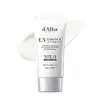What's inside
What's inside
 Key Ingredients
Key Ingredients

 Benefits
Benefits

 Concerns
Concerns

No concerns
 Ingredients Side-by-side
Ingredients Side-by-side

Water
Skin ConditioningCyclohexasiloxane
EmollientIsododecane
EmollientButyloctyl Salicylate
Skin Conditioning2,3-Butanediol
HumectantPropylheptyl Caprylate
EmollientCaprylyl Methicone
Skin ConditioningPolyglyceryl-3 Polydimethylsiloxyethyl Dimethicone
Skin ConditioningMagnesium Sulfate
Lauryl Polyglyceryl-3 Polydimethylsiloxyethyl Dimethicone
Skin ConditioningDisteardimonium Hectorite
StabilisingMethyl Methacrylate Crosspolymer
Polymethylsilsesquioxane
Triethoxycaprylylsilane
1,2-Hexanediol
Skin ConditioningPolyglyceryl-2 Dipolyhydroxystearate
Skin ConditioningAlumina
AbrasiveCitrus Aurantium Dulcis Oil
MaskingHippophae Rhamnoides Fruit Oil
Skin ProtectingPropylene Carbonate
SolventGlyceryl Caprylate
EmollientCaprylyl Glycol
EmollientCitrus Nobilis Peel Oil
MaskingEthylhexylglycerin
Skin ConditioningSodium Hyaluronate
HumectantLitsea Cubeba Fruit Oil
MaskingTocopherol
AntioxidantHydrolyzed Sodium Hyaluronate
Skin ConditioningCeramide NP
Skin ConditioningPanthenol
Skin ConditioningMelaleuca Alternifolia Leaf Water
AntimicrobialButylene Glycol
HumectantCentella Asiatica Leaf Extract
Skin ConditioningCentella Asiatica Extract
CleansingWater, Cyclohexasiloxane, Isododecane, Butyloctyl Salicylate, 2,3-Butanediol, Propylheptyl Caprylate, Caprylyl Methicone, Polyglyceryl-3 Polydimethylsiloxyethyl Dimethicone, Magnesium Sulfate, Lauryl Polyglyceryl-3 Polydimethylsiloxyethyl Dimethicone, Disteardimonium Hectorite, Methyl Methacrylate Crosspolymer, Polymethylsilsesquioxane, Triethoxycaprylylsilane, 1,2-Hexanediol, Polyglyceryl-2 Dipolyhydroxystearate, Alumina, Citrus Aurantium Dulcis Oil, Hippophae Rhamnoides Fruit Oil, Propylene Carbonate, Glyceryl Caprylate, Caprylyl Glycol, Citrus Nobilis Peel Oil, Ethylhexylglycerin, Sodium Hyaluronate, Litsea Cubeba Fruit Oil, Tocopherol, Hydrolyzed Sodium Hyaluronate, Ceramide NP, Panthenol, Melaleuca Alternifolia Leaf Water, Butylene Glycol, Centella Asiatica Leaf Extract, Centella Asiatica Extract
Phenylbenzimidazole Sulfonic Acid 1%
UV AbsorberHomosalate 15%
Skin ConditioningEthylhexyl Salicylate 5%
UV AbsorberZinc Oxide 15.5%
Cosmetic ColorantWater
Skin ConditioningDimethicone
EmollientTrisiloxane
Skin ConditioningSd Alcohol 40-B
AstringentGlycerin
HumectantSilica
AbrasivePEG/PPG-14/7 Dimethyl Ether
Skin ConditioningLauryl PEG-9 Polydimethylsiloxyethyl Dimethicone
Skin ConditioningPEG-10 Dimethicone
Skin ConditioningTrehalose
HumectantMyristyl Myristate
EmollientEthylhexyl Palmitate
EmollientDextrin Palmitate
EmulsifyingIsodecyl Neopentanoate
EmollientAscorbyl Tetraisopalmitate
AntioxidantThiotaurine
AntioxidantDipotassium Glycyrrhizate
HumectantScutellaria Baicalensis Root Extract
AstringentPaeonia Albiflora Root Extract
Skin ConditioningSodium Hyaluronate
HumectantSanguisorba Officinalis Root Extract
CleansingCamellia Sinensis Leaf Extract
AntimicrobialGarcinia Mangostana Bark Extract
Skin ConditioningPerilla Ocymoides Leaf Extract
TonicSpirulina Platensis Extract
Skin ProtectingTriethanolamine
BufferingTriethoxycaprylylsilane
Butylene Glycol
HumectantDisodium EDTA
Disteardimonium Hectorite
StabilisingTocopherol
AntioxidantBHT
AntioxidantAlcohol
AntimicrobialIsostearic Acid
CleansingMenthoxypropanediol
MaskingSodium Metabisulfite
AntioxidantPolysilicone-2
CI 77120
Cosmetic ColorantSodium Citrate
BufferingPhenoxyethanol
PreservativeBenzoic Acid
MaskingParfum
MaskingIron Oxides
Phenylbenzimidazole Sulfonic Acid 1%, Homosalate 15%, Ethylhexyl Salicylate 5%, Zinc Oxide 15.5%, Water, Dimethicone, Trisiloxane, Sd Alcohol 40-B, Glycerin, Silica, PEG/PPG-14/7 Dimethyl Ether, Lauryl PEG-9 Polydimethylsiloxyethyl Dimethicone, PEG-10 Dimethicone, Trehalose, Myristyl Myristate, Ethylhexyl Palmitate, Dextrin Palmitate, Isodecyl Neopentanoate, Ascorbyl Tetraisopalmitate, Thiotaurine, Dipotassium Glycyrrhizate, Scutellaria Baicalensis Root Extract, Paeonia Albiflora Root Extract, Sodium Hyaluronate, Sanguisorba Officinalis Root Extract, Camellia Sinensis Leaf Extract, Garcinia Mangostana Bark Extract, Perilla Ocymoides Leaf Extract, Spirulina Platensis Extract, Triethanolamine, Triethoxycaprylylsilane, Butylene Glycol, Disodium EDTA, Disteardimonium Hectorite, Tocopherol, BHT, Alcohol, Isostearic Acid, Menthoxypropanediol, Sodium Metabisulfite, Polysilicone-2, CI 77120, Sodium Citrate, Phenoxyethanol, Benzoic Acid, Parfum, Iron Oxides
Ingredients Explained
These ingredients are found in both products.
Ingredients higher up in an ingredient list are typically present in a larger amount.
Butylene Glycol (or BG) is used within cosmetic products for a few different reasons:
Overall, Butylene Glycol is a safe and well-rounded ingredient that works well with other ingredients.
Though this ingredient works well with most skin types, some people with sensitive skin may experience a reaction such as allergic rashes, closed comedones, or itchiness.
Learn more about Butylene GlycolDisteardimonium Hectorite comes from the clay mineral named hectorite. It is used to add thickness to a product.
It can also help stabilize a product by helping to disperse other ingredients.
Hectorite is a rare, white clay mineral.
Learn more about Disteardimonium HectoriteSodium Hyaluronate is hyaluronic acid's salt form. It is commonly derived from the sodium salt of hyaluronic acid.
Like hyaluronic acid, it is great at holding water and acts as a humectant. This makes it a great skin hydrating ingredient.
Sodium Hyaluronate is naturally occurring in our bodies and is mostly found in eye fluid and joints.
These are some other common types of Hyaluronic Acid:
Learn more about Sodium HyaluronateTocopherol (also known as Vitamin E) is a common antioxidant used to help protect the skin from free-radicals and strengthen the skin barrier. It's also fat soluble - this means our skin is great at absorbing it.
Vitamin E also helps keep your natural skin lipids healthy. Your lipid skin barrier naturally consists of lipids, ceramides, and fatty acids. Vitamin E offers extra protection for your skin’s lipid barrier, keeping your skin healthy and nourished.
Another benefit is a bit of UV protection. Vitamin E helps reduce the damage caused by UVB rays. (It should not replace your sunscreen). Combining it with Vitamin C can decrease sunburned cells and hyperpigmentation after UV exposure.
You might have noticed Vitamin E + C often paired together. This is because it is great at stabilizing Vitamin C. Using the two together helps increase the effectiveness of both ingredients.
There are often claims that Vitamin E can reduce/prevent scarring, but these claims haven't been confirmed by scientific research.
Learn more about TocopherolTriethoxycaprylylsilane is a silicone used to bind and stabilize ingredients.
As an emulsifier, it helps prevent ingredients from separating. This can help elongate the shelf life of products.
Triethoxycaprylylsilane is often used to coat mineral sunscreens ingredients to help give a better feel. It also helps reduce oxidative stress in sunscreens.
Learn more about TriethoxycaprylylsilaneWater. It's the most common cosmetic ingredient of all. You'll usually see it at the top of ingredient lists, meaning that it makes up the largest part of the product.
So why is it so popular? Water most often acts as a solvent - this means that it helps dissolve other ingredients into the formulation.
You'll also recognize water as that liquid we all need to stay alive. If you see this, drink a glass of water. Stay hydrated!
Learn more about Water